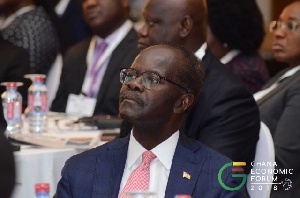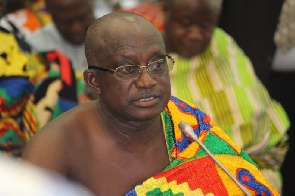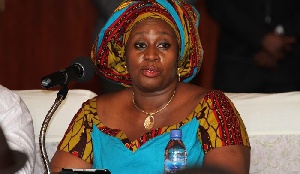Dr. George Domfe, a Development Economist and a Senior Research Fellow with the University of Ghana sought to find out when debt-to-GDP became the main indicator of economic development in his response to Sam Jonah’s epistles on the general economic situation of Ghana.
The senior citizen, Sir Sam Jonah, painted a gloomy picture of the Ghanaian economy in his address to rotary club last weekend when he particularly mentioned that “Ghana’s debt-to-GDP ratio is 76.1% under the watch of Dr Bawumia”.
Speaking to Oman FM’s morning show, Dr. Domfe clarified that debt-to-GDP ratio is just one of the numerous macroeconomic indicators used to assess performance of an economy. He went on to suggest that the Ghanaian economy is currently more robust than it was in a few years back.
“Average depreciation rate of the Cedi in the last 4 years hovered around 7% compared to the average of 17% between 2008 and 2016. Inflation has dropped from 15.4% in December 2016 to 10.3% in March 2021. Again, cost of credit in Ghana was the second highest in Africa in 2016 when policy rate was 25.5% with an accompanying average lending rate of 32%. Today, policy rate has significantly dropped to 14.5% dragging along with it, the average lending rate to 21%,” he explained.
He, therefore, challenged economic analysis by Sam Jonah and explained that the Ghanaian economy is doing relatively far better. On the debt-to-GDP ratio, he wondered why it was never an issue when in the year 2000 Ghana recorded a debt-to-GDP ratio of 182% [in 2006 constant prices].
He questioned why the voice of Sir Jonah was never heard when President Kufour managed [through HIPC] to bring down the debt-to-GDP ratio down to 26% in 2006. “If debt-to-GDP ratio of 76.1% is such a huge problem today, then Sir Jonah should have praised President Kufour when he met it at 182% in January 2001 and left it 32% in January 2009,” he lectured.
Dr. Domfe continued that a country’s debt becomes unsustainable when its debt-to-GDP ratio hits a threshold of 70% or above of its GDP. “Anytime an economy records beyond a debt-to-GDP ratio of 70%, its debt automatically becomes unsustainable and when this happens, debt services become possible only after compromising on the provision of goods and services to the citizens. In other words, once a country records debt-to-GDP ratio beyond 70%, construction of roads, building of hospitals, improving workers’ working conditions, among other things – could be sacrificed. Such situation obviously has adverse consequences for the welfare of the people,” he opined.
He explained further that, debt-to-GDP ratio mathematically is equal to the total nominal debt stock divided by GDP and multiplied by 100%. Small opened market economies such as Ghana, according to him, have been advised by IMF not to record beyond 70% of debt-to-GDP ratio.
On that note, he commended Sir Jonah for acknowledging that Ghana’s current debt-to-GDP ratio of 76.1% is unsustainable. But he was quick to ask “where was Sir Jonah when in 2014, 2015 and 2016, Ghana’s debt-to-GDP ratio went beyond the dreaded 70% threshold?” Indeed, Ghana’s debt-to-GDP ratio was 73.1% [in 2006 constant prices] – rendering the country’s debt situation highly unsustainable.
In 2017, Ghana left the danger zone narrowly when it recorded debt-to-GDP ratio of 69.8%. He went on to explain that in the year 2018, Ghanaian economy was rebased [away from 2006 constant prices to 2013 constant prices] and the economy became 24.5% bigger. As a result, the debt-to-GDP of 73.1% in 2006 was recalculated to be 57.1%. “It was this 57.1% debt-to-GDP in 2016 that crawled to 62.8% at end of 2019” he observed and went on to question why Sir Jonah never parsed the Akuffo Addo led Government for that sterling performance in managing Ghana’s debt situation during the first three years of the Government?
“Not only was the debt-to-GDP ratio crawling in those years but Ghana recorded its first positive primary balance in 15 years in 2017 and maintained this feat through 2018 and 2019.”
He explained that recording positive primary balance in these years meant that without interest payments, Ghana’s total revenue was always higher than its expenditure. What an incredible performance in debt management!! Indeed, the international community praised Ghana for such a sterling performance.
He acknowledged and supported Sir Jonah’s appreciation of the current weak fiscal stance of the Ghanaian economy but shed some light on the situation, “Yes, it is true that the current fiscal stance is not pleasant, but we should understand why – Ghana had projected to spend GHS 85 billion in 2020 and rake in GHS66 billion as revenue – which should have translated into 4.7% of GDP as fiscal deficit – to keep us within the 5% maximum threshold required by the law [Fiscal Responsibility ACT].
Unfortunately, there was a certain COVID-19 pandemic that swept away the projections. Eventually, the country spent about GHS 19 billion more and recorded a revenue shortfall of GHS 11 billion [of the initial projections]. Significantly as a result, the debt-to-GDP ratio ballooned to 76.1% in 2020 from 62.8% in 2019”.
He further explained that his main concern with Sir Jonah’s economic analysis is his refusal to, firstly acknowledge the efforts made in the previous three years in managing Ghana’s debt situation and secondly, deciding not to talk about the adverse consequences of COVID-19 pandemic – that mainly stimulated the wide yawning gap between expenditure and revenue in 2020. He voiced out his disappointment and called on Sir Sam Jonah to come again with a better analysis of the country’s current fiscal stance.
- Performance Tracker: Beatrice Annan exposes government for listing Dodowa Hospital as part of Akufo-Addo’s achievement
- What exactly is your grand plan? - Franklin Cudjoe asks Akufo-Addo over sacking of SSNIT, GRA bosses
- Ghana is doing well, don't negate what we have achieved because NPP is in office – Nana Ofori-Atta
- Meet the 8 'prominent' lawyers Akufo-Addo has penciled to be justices of the Court of Appeal
- 58% of voters in the Ashanti Region say Ghana is heading in the wrong direction – Poll
- Read all related articles













